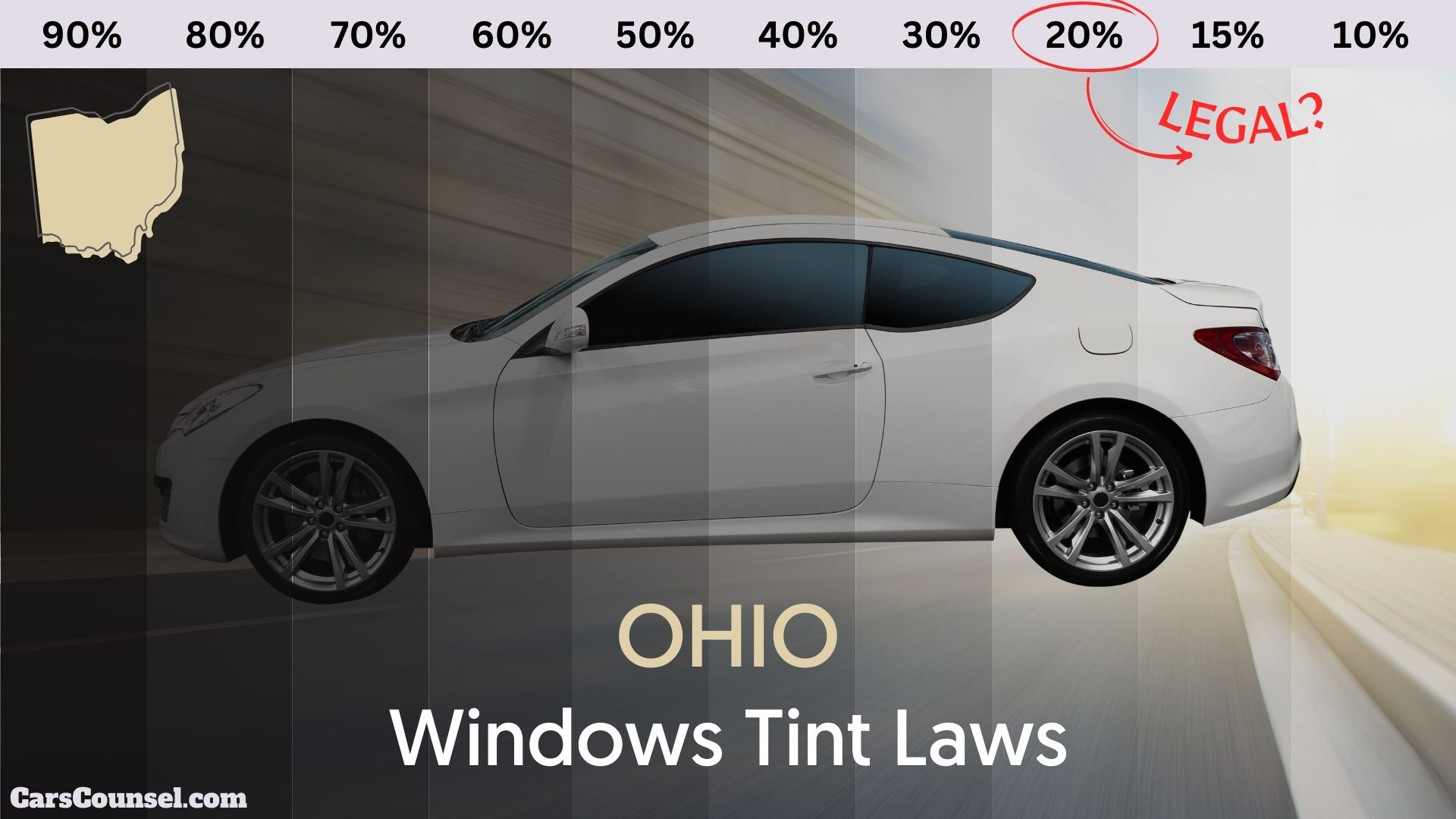You might be surprised to learn that Ohio has specific rules governing the darkness of your vehicle’s window tint. For instance, did you know that the top 5 inches of your windshield can have non-reflective tint, but the rest must allow at least 70% of light to pass through?
That’s just the beginning – there are more regulations to navigate, from front side windows to rear windows, and even specific requirements for manufacturers. If you’re considering getting your windows tinted, it’s essential to understand the nuances of Ohio’s window tinting laws to avoid penalties and fines.

Quick Navigation
Window Tint Darkness Rules
In terms of window tint darkness rules in Ohio, there are specific regulations you need to be aware of to guarantee adherence.
According to Ohio window tint law, the windshield can have a non-reflective tint allowed on the top 5 inches, but the rest of the windshield must allow at least 70% of light to pass through.
Front side windows must allow more than 50% of light to pass through, with a 3% tolerance.
As regards Darkness for SUV and other vehicles, back side windows and rear windows can have any darkness of tint.
[carscounsel_tint_calculator show_state=”true” default_state=”OH”]
Window Tint Reflection Laws
Your vehicle’s window tint reflection is crucial to ponder, as Ohio has specific laws governing the level of reflectivity allowed.
In regards to window tint reflection laws in Ohio, you need to guarantee that your vehicle’s tint film doesn’t exceed the permitted level.
The state requires that the reflection not exceed 25% on the windshield and front side windows. This means that your window tint should allow at least 75% of available light to pass through.
Failure to comply with these window tint laws can result in penalties and fines.
Make sure to check the VLT (Visible Light Transmission) of your tint film, which should be at least 70% for the windshield and 60% for the front side windows, measured in inches.
Ohio Window Tint Regulations
Ohio’s window tint regulations are in place to guarantee driver and passenger safety on the state’s roads.
As you consider getting your car windows tinted, it’s essential to understand these regulations. Ohio tinting laws dictate that the VLT (Visible Light Transmission) on your windshield and front side windows must allow at least 70% of visible light to pass through.
The regulations pertaining to window tinting also prohibit any window reflection that could obstruct your view while driving. Ohio laws make it clear that only non-reflective tint is allowed on all car windows.
Certify you comply with these window tinting laws to avoid any legal issues.
Window Tinting Services Available
Now that you’re familiar with Ohio’s window tint regulations, you’re likely wondering what options are available to you.
In terms of window tinting, Ohio offers a range of services to suit your needs.
- Auto Tint provides UV protection, privacy, and style for your vehicle, guaranteeing a safe and comfortable drive.
- Home Tint and Commercial Film offer innovative solutions for your residential and business properties, including UV protection, privacy, and energy-saving benefits.
- Paint Protection Film safeguards your vehicle from rock chips, salt, insects, and road debris.
Remember to consult with a certified film professional to verify legal tinting that complies with Ohio tint laws and Visible Light Transmission standards.
You can get quotes for all window tinting services from Tint Guy.
Ohio State Window Tint Laws
What do you need to know about Ohio’s window tint laws?
Ohio has specific regulations for window tinting. The front windshield can have a non-reflective tint on the top 5 inches, but the rest must allow at least 70% of light to pass through.
| Window Position | VLT % | Reflectorized Materials |
|---|---|---|
| Front Windshield | ≥ 70 | Not allowed |
| Front Side Windows | > 50 | Not allowed |
| Back Side Windows | Any | Not allowed |
| Rear Window | Any | Not allowed |
Manufacturers must certify that their tinted film meets Ohio’s specifications, and a sticker identifying legal tinting is required on each tinted window. There are no medical exemptions for special tint in Ohio, and violators may face fines and penalties.
Tint Law References
Ohio Revised Code Section 4513.241: Using tinted glass and other vision obscuring materials
Car Window Tinting Laws By State
Click on the state you’re interested in for a complete guide to its tint laws and regulations. If you spot any errors, let us know through our contact page.
| State | Front Side Windows | Back Side Windows | Rear Windows | Windshield |
|---|---|---|---|---|
| Alabama | 32% | 32% | 32% | 6 inches |
| Alaska | 70% | 40% | 30% | 5 inches |
| Arizona | 33% | ANY | ANY | tinting allowed to the top of the manufacturer’s as-1 line |
| Arkansas | 25% | 25% | 10% | 5 inches |
| California | 70% | ANY | ANY | 4 inches |
| Colorado | 27% | 27% | 27% | 4 inches |
| Connecticut | 35% | 35% | ANY | non-reflective tint above the as-1 line top 6 inches |
| Delaware | 70% | ANY | ANY | non-reflective tint above the as-1 line top 6 inches |
| Florida | 28% | 15% | 15% | non-reflective tint above the as-1 line |
| Georgia | 32% | 32% | 32% | 6 inches |
| Hawaii | 35% | 35% | 35% | Non-reflective tint is allowed on the top 4 inches of the windshield |
| Idaho | 35% | 20% | 20% | non-reflective tint above the as-1 line |
| Illinois | 35% | 35% | 35% | 6 inches |
| Indiana | 30% | 30% | 30% | non-reflective tint above the as-1 line |
| Iowa | 70% | ANY | ANY | non-reflective tint above the as-1 line |
| Kansas | 35% | 35% | 35% | non-reflective tint above the as-1 line |
| Kentucky | 35% | 18% | 18% | non-reflective tint above the as-1 line |
| Louisiana | 40% | 25% | 12% | non-reflective tint above the as-1 line top 6 inches |
| Maine | 35% | 35% | 35% | top 4 inches |
| Maryland | 35% | 35% | 35% | top 5 inches |
| Massachusetts | 35% | 35% | 35% | top 6 inches |
| Michigan | 35% | ANY | ANY | top4 inches |
| Minnesota | 50% | 50% | 50% | Top 6 inches |
| Mississippi | 28% | 28% | 28% | non-reflective tint above the as-1 line top 5 inches |
| Missouri | 35% | ANY | ANY | non-reflective tint above the as-1 line top 6 inches |
| Montana | 24% | 14% | 14% | non-reflective tint above the as-1 line top 6 inches |
| Nebraska | 24% | 20% | 20% | top 6 inches or as-1 line, whichever comes first |
| Nevada | 35% | ANY | ANY | non-reflective tint above the as-1 line top 6 inches |
| New Hampshire | 35% | 35% | 35% | Allowed for the manufacturer’s AS-1 line |
| New Jersey | Illegal | ANY | ANY | Top 6 inches |
| New Mexico | 20% | 20% | 20% | 5 inches or as-1 line, whichever comes first |
| New York | 70% | 70% | 70% | top 6 inches |
| North Carolina | 35% | 35% | 35% | non-reflective tint above the as-1 line top 6 inches |
| North Dakota | 50% | ANY | ANY | Top 6 inches |
| Ohio | 50% | ANY | ANY | Top 5 inches |
| Oklahoma | 25% | ANY | ANY | 5 inches or as-1 line, whichever comes first |
| Oregon | 35% | 35% | 35% | Top 6 inches |
| Pennsylvania | 70% | 70% | 70% | Top 3 inches |
| Rhode Island | 70% | 35% | 35% | non-reflective tint above the as-1 line top 6 inches |
| South Carolina | 27% | 27% | 27% | non-reflective tint above the as-1 line top 6 inches |
| South Dakota | 35% | 20% | 20% | non-reflective tint above the as-1 line top 6 inches |
| Tennessee | 35% | 35% | 35% | non-reflective tint above the as-1 line top 6 inches |
| Texas | 25% | 25% | 25% | 5 inches or as-1 line, whichever comes first |
| Utah | 43% | ANY | ANY | non-reflective tint above the as-1 line top 4 inches |
| Vermont | 70% | ANY | ANY | ILLEGAL |
| Virginia | 50% | 35% | 35% | non-reflective tint above the as-1 line top 6 inches |
| Washington | 24% | 24% | 24% | Top 6 inches |
| West Virginia | 35% | 35% | 35% | Top 5 inches |
| Wisconsin | 50% | 35% | 35% | non-reflective tint above the as-1 line top 6 inches |
| Wyoming | 28% | 28% | 28% | Top 5 inches or as-1 line, whichever comes first |

